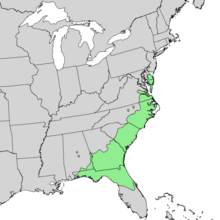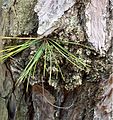
A pine is any conifer tree or shrub in the genus Pinus of the family Pinaceae. Pinus is the sole genus in the subfamily Pinoideae.

Pinus albicaulis, known by the common names whitebark pine, white bark pine, white pine, pitch pine, scrub pine, and creeping pine, is a conifer tree native to the mountains of the western United States and Canada, specifically subalpine areas of the Sierra Nevada, Cascade Range, Pacific Coast Ranges, and Rocky Mountains. It shares the common name "creeping pine" with several other plants.

Pinus sabiniana, with vernacular names including towani pine, foothill pine, gray pine, bull pine, and digger pine, is a pine endemic to California in the United States. Some sources discourage using the name "digger pine," considering it pejorative.
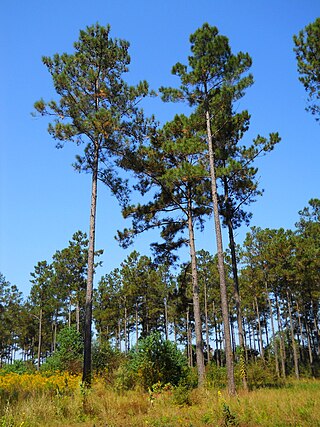
Pinus taeda, commonly known as loblolly pine, is one of several pines native to the Southeastern United States, from East Texas to Florida, and north to southern New Jersey. The wood industry classifies the species as a southern yellow pine. U.S. Forest Service surveys found that loblolly pine is the second-most common species of tree in the United States, after red maple. For its timber, the pine species is regarded as the most commercially important tree in the Southeastern U.S. The common name loblolly is given because the pine species is found mostly in lowlands and swampy areas.

The Torrey pine is a rare pine species in California, United States. It is a critically endangered species growing only in coastal San Diego County, and on Santa Rosa Island, offshore from Santa Barbara in Santa Barbara County. The Torrey pine is endemic to the California coastal sage and chaparral ecoregion.

Pinus jeffreyi, also known as Jeffrey pine, Jeffrey's pine, yellow pine and black pine, is a North American pine tree. It is mainly found in California, but also in the westernmost part of Nevada, southwestern Oregon, and northern Baja California. It is named in honor of its botanist documenter John Jeffrey.

Pinus contorta, with the common names lodgepole pine and shore pine, and also known as twisted pine, and contorta pine, is a common tree in western North America. It is common near the ocean shore and in dry montane forests to the subalpine, but is rare in lowland rain forests. Like all pines, it is an evergreen conifer.
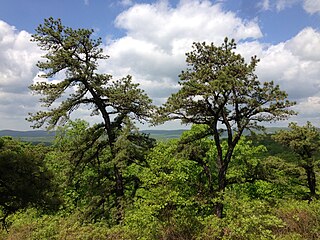
Pinus rigida, the pitch pine, is a small-to-medium-sized pine. It is native to eastern North America, primarily from central Maine south to Georgia and as far west as Kentucky. It is found in environments which other species would find unsuitable for growth, such as acidic, sandy, and low-nutrient soils.

The shortleaf pine (or Pinus echinata) is a softwood conifer tree that has short needles and small cones. The species is mainly found in southeastern United States, and can inhabit various climates. The shortleaf pine is sometimes referred to as the "old field", "spruce", "rosemary", "yellow", "two-leaf" and "heart" pine; however, there is a true shortleaf pine that is different from these pine variations. The confusion stems from a custom in the Southeastern United States to only refer to pines as either "long-leaf" or "short-leaf". Furthermore, the pine can be distinguished from other pines by examining their short leaves and small cones.

Pinus elliottii, commonly known as slash pine, is a conifer tree native to the Southeastern United States. Slash pine is named after the "slashes" – swampy ground overgrown with trees and bushes – that constitute its habitat. Other common names include swamp pine, yellow slash pine, and southern Florida pine. Slash pine has two different varieties: P. e. var. elliottii and P. e. var. densa. Historically, slash pine has been an important economic timber for naval stores, turpentine, and resin. The wood of slash pine is known for its unusually high strength, especially for a pine. It exceeds many hardwoods and is even comparable to very dense woods such as ironwood.

Pinus virginiana, the Virginia pine, scrub pine, Jersey pine, possum pine, is a medium-sized tree, often found on poorer soils from Long Island in southern New York south through the Appalachian Mountains to western Tennessee and Alabama. The usual size range for this pine is 9–18 m, but can grow larger under optimum conditions. The trunk can be as large as 20 inches diameter. This tree prefers well-drained loam or clay, but will also grow on very poor, sandy soil, where it remains small and stunted. The typical life span is 65 to 90 years.
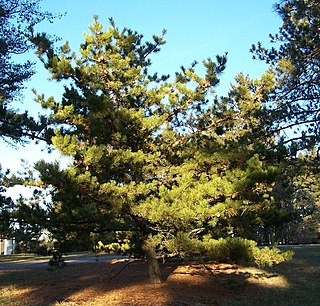
Table Mountain pine, Pinus pungens, also called hickory pine, prickly pine, or mountain pine, is a small pine native to the Appalachian Mountains in the United States.
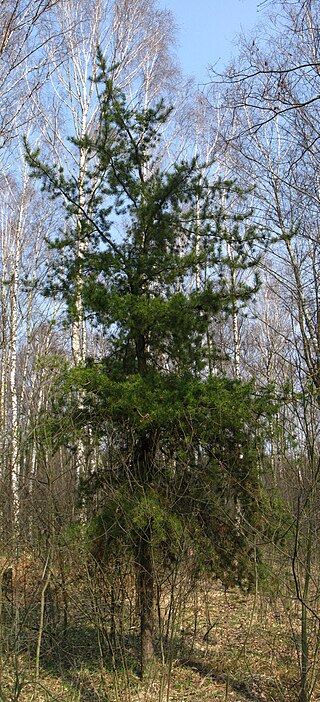
Jack pine, also known as grey pine or scrub pine, is a North American pine.

Coulter pine, or big-cone pine, is a native of the coastal mountains of Southern California in the United States and northern Baja California in Mexico. Isolated groves are found as far north as Clearlake, California on the flanks of Mt. Konocti and Black Diamond Mines Regional Preserve. It is named after Thomas Coulter, an Irish botanist and physician. The Coulter pine produces the heaviest cone of any pine tree, up to 5 kg (11 lb) and among conifers is exceeded only by the cones of Araucaria bidwillii.

Pinus ponderosa, commonly known as the ponderosa pine, bull pine, blackjack pine, western yellow-pine, or filipinus pine is a very large pine tree species of variable habitat native to mountainous regions of western North America. It is the most widely distributed pine species in North America.

Pinus leiophylla, commonly known as Chihuahua pine, smooth-leaf pine, and yellow pine, is a tree with a range primarily in Mexico, with a small extension into the United States in southeast Arizona and southwest New Mexico. The Mexican range extends along the Sierra Madre Occidental and Sierra Madre del Sur from Chihuahua to Oaxaca, from 29° North Lat. to 17°, between 1600 and 3000 meters altitude. It requires about a rainfall 600 to 1000 mm a year, mostly in summer. It tolerates frosts in winter.
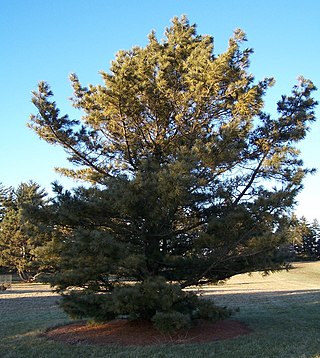
Pinus koraiensis is a species of pine known commonly as the Korean pine. It is a relic species of the Tertiary, identified as a rare tree species by United Nations. It is native to eastern Asia: Korea, northeastern China, Mongolia, the temperate rainforests of the Russian Far East, and central Japan. In the north of its range, it grows at moderate elevations, typically 600 to 900 metres, whereas further south, it is a mountain tree, growing at 2,000 to 2,600 m elevation in Japan. Other common names include Chinese pinenut. The ancient woodland of P. koraiensis on the earth is about 50 million hectares, and China has about 30 million hectares, accounting for 60%. It is a second-class national key protected plant in China. P. koraiensis is a tree species with high economic and ecological value. The official name in Chinese is "红松 hóng sōng/red pine", because almost every part of it is related to red.

Pinus thunbergii, the black pine, Japanese black pine, or Japanese pine, is a pine tree native to coastal areas of Japan and South Korea.

Pinus bungeana, also known by the common names Bunge's pine, lacebark pine and white-barked pine, is a pine tree native to northeastern and central China. It is a slow-growing tree that can grow to heights of 15–25 metres (49–82 ft) is frost hardy down to below −26 °C (−15 °F). Its smooth, grey-green bark gradually sheds in round scales to reveal patches of pale yellow, which turn olive-brown, red and purple on exposure to light.

Pocosin is a type of palustrine wetland with deep, acidic, sandy, peat soils. Groundwater saturates the soil except during brief seasonal dry spells and during prolonged droughts. Pocosin soils are nutrient-deficient (oligotrophic), especially in phosphorus.

